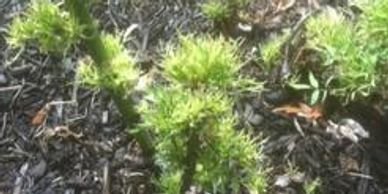Diseases
Blackspot
Powdery Mildew
Downy Mildew

Fungus: Dialocarpon rosae Black spot is a fungus that starts by growing in colonies on rose leaves. It becomes active under humid wet conditions. The result is fuzzy edged rounded blackish or purplish spots on the leaves. On the cane it appears as raised dark reddish or black spots. Blackspot usually does not occur in early spring but starts to show up in early or mid summer. The fungus then spreads across the leaf until the leaf turns completely yellow and then falls off resulting in a defoliated bush. When the spot comes in contact with a vein is crosses it. Black spot must be controlled before the symptoms occur. The treatment is more preventative than curative using specific fungicides on a regular 10-14 day cycle. Spray should begin soon after the bush produces leaves and continue throughout the growing season.
Downy Mildew
Powdery Mildew
Downy Mildew

Fungus: Peronospora sparsa Downy mildew appears as blackish or dark red stains on the upper surface of the leaves and stems. When the spot comes to a vein it follows it. Downy mildew often occurs when humidity gets above 85% and temperature is below 75 degrees. It can also affect the bud causing it to look distorted. Treatment involves good ventilation, treatment with specialized fungicides and application of dormant oil during the dormant period to kill overwintering spores. Downy mildew is more serious than Black Spot.
Powdery Mildew
Powdery Mildew
Rose Rosette Disease

Fungus: Sphaetotheca pannosa Powdery Mildew shows itself as a bumpy blister surface on young leaves, followed by white powder like substance occurring on the top surface of leaves and flower buds and occasionally on stems. Infected leaves crumble and become distorted. Powdery mildew is most likely to occur when there are cool nights and warm days or when there is a lot of moisture around the rose that is not able to evaporate during the day. One of the best ways to avoid powdery mildew is to allow air flow between bushes. Chemical treatment should be made as soon as the fungus is noticed. Special fungicides are available to treat powdery mildew.
Rose Rosette Disease
Rose Rosette Disease
Rose Rosette Disease

RRD was first identified in the Rockies in the 1940'.It has spread across the US over the last 70 years and is now reported in most US States. It is vectored and transmitted by one species of Eriophyoid mites. These mites are barley visible to the naked eye and can more easily be seen with a 20x hand lens. The mites transmit the infectious agent which has been identified as a virus. These mites do not fly but rather balloon into the air and are carried into the upper atmosphere where they land in other regions. Early symptoms of the disease include red elongated stem growth, deformed flowers, unopened buds and witches broom like clusters. RRD is not to be mistaken for herbicide damage which can produce similar results. RRD leads to a reduction of starch within the plant and eventually the bush dies. Currently, research teams across the country are conducting research to develop roses resistant to RRD and find ways to kill and control the mite that transmits the disease.
Herbicide Damage
Rose Rosette Disease
Herbicide Damage

Damage caused by Roundup leads to small leafing structures on the canes that are deformed.
Rust
Rose Rosette Disease
Herbicide Damage

This fungus is caused by Phragmidium species and will present in the spring and persist through the entire summer. It will present on the leaves with orange or black pustules and on the stem with orange pustules. Leave will eventually turn yellow and drop from the bush. This disease will over winter in the leaf litter on the ground. Cleaning up your rose garden in the fall and early spring can help prevent reinfection of bushes. Use of chemical treatment and pruning will treat the disease.